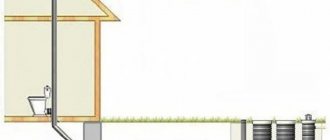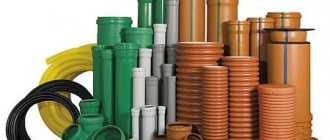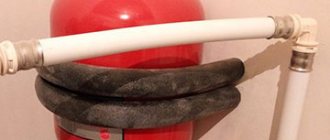At the design stage, and then during installation, it is necessary to strictly observe the angle of inclination of the sewer pipes. And it doesn’t matter whether it is an internal or external sewage system, the pipeline must have a slope.
This is due to the fact that the sewer system in most cases is gravity-fed, that is, wastewater is delivered to the treatment plant under the influence of gravity. Even a slight deviation from the standards will lead to the malfunction of the entire system.
Why is the bias made?
In order for the water flow in the sewer to wash away solid particles, the pipes must be laid at an angle. In this case, the angle of inclination of the sewerage system must comply with the standards established by SNiP. But in pursuit of installation speed or using the labor of unskilled workers, you can end up with a sewer system made with serious errors:
- Ignoring the established standards, they do not make a slope at all or the sewer angle is very small. Thus, the movement of wastewater will be excessively slow and plugs of solid particles will begin to form in the pipes. Very quickly this will lead to the need to clean out the entire sewer system, because if a toilet is installed, but the pipe slope is not adjusted, then there will be practically no flushing and feces will begin to decompose right in the pipes, spreading the smell throughout the house.
- The angle of the sewer pipe is made too large. In this case, the drains through the pipes will move too quickly, washing the solid particles, but not taking them with them. This fact will again lead to clogged pipes, which will have to be cleaned regularly.
If the angle of inclination is incorrect, the water flow does not work Source termo-house.com
Do not neglect the standards established in SNiP, since they were determined based on calculations and observations over many years.
Indicators of the angle of inclination of the sewerage system in a private house
An indicator such as the angle of inclination of a pipe when installing a drainage system in a private house means the degree of change in its location relative to the horizontal line. The size of the slope angle is calculated as the difference in height between the lowest point of the pipeline surface at its beginning and at its end. In the standard measurement system, angles are expressed in degrees for comparison.
If a pipe with a diameter of 50 millimeters is used, the slope per linear meter will be 0.03 m. For example, with a four-meter pipeline length, the difference in height will be equal to (0.03x4) or 12 centimeters.
In order to avoid mistakes when creating a sewer system, the slope per meter is determined using the correct calculation method.
Correct sewer slope
For those who do not know how exactly the data in SNiP documents is deciphered, it should be kept in mind that all standards are indicated in the form of fractions. For example, the inscription 0.03 and 0.008 reads as follows: a pipe one meter long at one end rises by three centimeters, at the other it is raised only eight millimeters. If there is only one number, it means one end of the pipe is at the zero mark, and the other is raised to a given height.
Since the sewer pipeline is much longer than a meter, a formula is used to measure the slope, where the upper end of the pipe is determined as follows: based on the standards, for example, three centimeters of slope is taken per meter, which is multiplied by the entire length of the pipe. As a result, it will be determined how far the upper end of the pipeline needs to be raised.
With a pipe length of 25 meters, the calculation looks like this: 3 * 25 = 75. That is, the slope of the sewer pipe should be 75 centimeters at one end.
SNiP standards for the angles of inclination of sewer pipes depending on their diameter Source pinterest.com
Since sewerage is laid not only in the house, but also outside it, the slope is maintained throughout the entire pipe. At the same time, it is determined depending on the diameter of the pipes - the smaller it is, the greater the slope. There are times when it is impossible to meet the standards, in which case small deviations are allowed. But it should be taken into account that in this case everything must be carefully calculated so that there are no problems with the operation of the sewerage system.
See also: Catalog of companies that specialize in water supply and sewerage.
SNIP requirements for inclination angle
A pipeline that receives wastewater from the internal sewer system and transports it to a septic tank or to the city network is an external sewer system. However, the volume of runoff from low-rise buildings and outbuildings is small (for a private house 1–5 m3 per day). Its supply and degree of pollution are uneven. Therefore, it makes sense to use the rules and regulations governing the construction of both city and internal sewerage systems.
Design parameters of the drainage pipeline connecting the internal and street networks:
- the smallest diameter and sufficient for efficient operation is 150 mm;
- its characteristic slope values are 0.008–0.01 (for 200 mm pipes - 0.007).
In practice, for an autonomous gravity-flow sewer system in a cottage, the minimum diameter is taken to be 100 mm (then the water supply is “deviated” more strongly).
A prerequisite for installing a floating sewer system is the presence of a water supply system in the building. It will provide a volume of flow (at least 60 liters per inhabitant per day), capable of diluting pollution to an extent that will allow it to be transported by gravity in a closed channel.
Average daily water disposal is assumed to be equal to average daily water consumption minus the volume of water for irrigation. (The presence of hot water supply in the cottage increases the daily consumption - up to 250 liters per person).
The choice of sewerage system (autonomous, local, centralized), the method of treatment and disposal of wastewater are consistent with Rospotrebnadzor, and when discharged into a water body, with Rosprirodnadzor and Rosvodresursy.
Pipeline bottom elevations are determined by thermal engineering calculations or analysis of the use of existing communications in a given area. As a last resort, pipes up to 500 mm in diameter are buried 0.3 m above the lowest level of soil freezing.
One way or another, burial is considered safe if at least 70 cm remains from its top to the surface of the earth (if vehicle passage is excluded - 50 cm).
The maximum drop in pipeline marks is 15 cm per meter. (The highest design flow velocity of the medium is 8 m/s in metal and plastic pipes, 4 m/s in concrete).
The penetration may also be excessive. The weight of which soil layer the structure can withstand is determined by the calculation based on soil conditions, material and size.
When designing an autonomous sewer system, it is necessary to take into account the sanitary and hygienic requirements for autonomous water supply (in particular, to reduce to zero the likelihood of contamination of aquifers due to leaks from underground filtration structures).
Everything about sewerage in a private house: diagram, installation depth, calculations.
Carrying out sewer installation work in a private house with your own hands - read on.
Reliable drainage system around the house: do-it-yourself device.
What to do if it is impossible to maintain the desired tilt
There are cases when difficulties arise during installation, leading to the fact that the angle of inclination of the sewer differs significantly from the permissible standards. In this case, take the following measures:
If calculations show that deviation from the specified standards is possible, then lay the pipes, but at the same time make additional tees at a certain distance through which the pipes will be cleaned.
When laying the pipe, still adhere to the recommendations, but in difficult areas, establish height differences, which are organized through additional wells. Thanks to this solution, it will be possible to install the pipe at the desired angle. There can be one or several such wells, but correct calculations and installation guarantee proper operation of the sewerage system.
There are several ways to achieve the desired slope of sewer pipes Source vodasovet.ru
As a last resort, if it is impossible to maintain the required slope and calculations show that the operation of the sewage system by gravity is impossible, then you will have to use a fecal pump. This device can be installed both on a local sewer branch and for the entire system.
When laying pipes made of plastic, you can be sure that they will need to be cleaned much less frequently than cast iron, since the smooth inner surface of the walls allows solid substances to slide.
Prices for materials and installation
The length of communications and their cost will be reduced by the compact location of objects (houses, septic tank - if the sewerage system is autonomous, the connection point to the city sewer - if the drainage system is centralized). When choosing bends, they are guided by their price, costs of delivery, installation, drainage during work.
The cost of construction per unit length of the sewer system is affected by diameter, material, laying depth, and hydrogeological conditions. The volume of excavation work will decrease if the average slope of the terrain and the actual pipeline coincide.
How to choose sewer pipes in a private house, details here.
Everything about connecting to the city water supply network in a private house: documentation, work, prices, sample documents.
The total cost of installing a street sewer system without connecting to a collector in a small suburban area varies from 40, 50 thousand rubles. up to 100. The figures are approximate, reflecting the “order” of prices, since the factors for each individual object vary too much.
The main expense items that form the final amount:
- installation of septic tank or filter pit rings, engineering work (one ring with work - ~ 5,000 rubles);
- digging wells (~ 20,000 for 2 glasses, with lowering rings);
- treatment of rings with bitumen mastic (~ 2000 rub.);
- removal of earth when constructing wells (RUB 2,000–4,000);
- hatch with a lid (depending on the material and load withstand (plastic - 3000–4000 rubles);
- bottom of wells (RUR 3,000–3,500, including work);
- pipeline laying (~ 1000 rubles per cubic meter of excavation work, with laying - ~ 1500 rubles).
If there are problems with the delivery and installation of concrete rings, a brick well may be advantageous.
Maintaining the angle
Determining the angle of inclination of the sewer pipe is only half the battle. The main difficulty is to maintain it during installation, for which they use a special level with an inclinometer.
Level with electronic goniometer Source tarnaya-doska.ru
If for some reason the protractor does not work, but knowledgeable craftsmen can maintain the desired slope using a regular level. There are several methods for this, and for each of them you need to do a little preparation:
- An oblique line is drawn on the wall corresponding to the selected slope. A level is applied to it and a mark is placed on it in the area of the air bubble. After this, the pipe is aligned in accordance with the location of the bubble. The method is not very reliable, as it allows for a certain error.
- Using a meter level, a special lining is used that will correspond to the angle of inclination.
Preparing for work
Before you begin installing the sewer system, you will need to prepare the following tools and materials:
- plastic pipes that have a cross-section of 5 and 10 centimeters;
- elements that will be used to connect pipes;
Pipes and connecting elements for sewerage installation Source 911stroy.ru
- cuffs for sealing joints;
- glue intended for gluing plastic;
- marker, tape measure, level and saw;
- cement.
If the sewer system is not being made new, but the existing one is being reconstructed, then before proceeding with installation, you need to study the old structure or photograph it. After this, you need to draw up a plan for installing the new system:
- a drawing is drawn onto graph paper, where all wiring points and bathrooms are displayed, distances are determined and the riser is marked;
- it is checked that the new plan coincides with the existing sewer system;
- then calculations are made and the amount of material required is determined.
Autonomous sewer ventilation diagram
The presence of ventilation in the sewer pipeline connecting it to the atmosphere affects the flow rarefaction. (∆p, mm water column). Without ventilation, it depends on the flow rate of the water-air mixture. (Air is entrained by wastewater, the more intensely, the smaller the pipe diameter, and hence the flow rate).
The principle of supply and exhaust ventilation is the difference in pressure between outside air and gases in the system. Pressure equalization, compensation for vacuum flow by suction from outside, prevents breakdown of hydraulic valves of internal sewerage.
In addition, ventilation prevents the formation of an aggressive environment: it removes gases (hydrogen sulfide, ammonia, carbon dioxide, methane, ammonia) and vapors that are emitted by the wastewater itself.
Free-flow sewer lines are reliable if the pipes and connections are resistant to corrosion damage not only by the transported liquid, but also by the gaseous environment of the above-water space.
Exhaust ventilation is implemented through elements of the internal sewer network - risers. They are led outside the building through the attic and roof.
The exhaust part of the riser (the one located above the attic floor) is brought to the height:
- 0.3 m from the roof plane;
- from the pitched roof - 0.5 m;
- 3 m - from the roof being used.
The air flow occurs through the covers of the inspection wells, which do not fit tightly to the hatches.
How to choose pipes
When choosing pipes, you need to pay attention to their color - sewer pipes are painted gray. The different cross-sectional diameters indicate that each type is designed to perform separate functions.
If an existing sewer system is being reconstructed, the operation of which has had no complaints, then the easiest way is to compare the diameter of the old pipes with the new ones - errors in this case are practically eliminated.
Depending on the purpose, sewer pipes and tees come in different diameters Source besplatka.ua
In addition, during installation you need to take into account what household appliances will be connected to the system. To drain water from a dishwasher and washing machine, a diameter of 2.5 centimeters will be enough; for a bathtub and shower you will need 3.5 centimeters. In general, pipes no larger than 5 centimeters in diameter are installed throughout the house, but for the riser you will need to purchase a pipe with a cross-section of 11 centimeters.
In order not to buy unnecessary materials or miscalculate, it is best to measure the old pipes and make a purchase accordingly. In addition, in accordance with the old design, the same number of connecting elements is purchased.
Calculation of pipe fullness
SNiP 2.04.01-85 (clause 18.2) provides the following formula for hydraulic calculation of sewerage:
V × √H/D ≥ K , where
V is the speed of wastewater movement in m/s;
H/D - filling, where H is the level of the water layer in the pipe, D is the diameter of the pipeline;
K – coefficient equal to 0.5 for polymer pipes and 0.6 for communications made of other materials.
The SNiP 2.04.01-85 standards indicate that in practice the speed of liquid flow should not be less than 0.7 m/s with a minimum filling of pipes of 0.3. As can be seen from the formula, the pipeline will be maximally filled when the H/D ratio is equal to one, that is, the optimal filling value should be in the range from 0.3 to 1.
In practical use, they try to maintain the fill rate in the range of 0.5 - 0.6, that is, if the sewer pipes have a diameter of 110 mm, then when filled with drainage to a height of 60 mm, the fill rate will be 60 mm / 110 mm = 0.545 mm. This indicator corresponds to the optimal value when using hydraulically smooth PVC sewer pipes.
Examples of installation of individual sewerage
Execution of work
After all the preparatory work has been completed, you can proceed directly to installation. First of all, you need to disassemble the old system. The work is carried out as follows:
- First, problem areas are identified where additional work will have to be carried out. This could be where the pipe goes through the wall.
- Using a chisel, the dismantling of cast iron pipes begins. In this case, cast iron must not be allowed to enter the main line of the sewer system. Otherwise, it may malfunction.
Working with cast iron sewerage is not the most aesthetically pleasing sight. Source domvpavlino.ru
- If replacement of the main riser is not expected, then the pipe from it is sawed off using a grinder.
After dismantling has been carried out, work stops until the connecting units cool completely.
Installation of modern plastic pipes can be done in two ways.
Installation of plastic pipes using glue
- pipes are cut into pieces of the required length;
- the edges are cleaned with sandpaper;
- the edges are degreased;
- pipes are checked for compatibility;
- glue is applied in the right places;
- the processed elements are connected to each other;
- when two pipes are compressed, a roll is formed, reminiscent in color of liquid honey;
- The glue dries within an hour.
Installation of plastic pipes using welding
- installation also begins with cutting pipes to the required length and stripping;
- the soldering device heats up to a temperature of at least 260 degrees;
- connectors and pipe are fixed on the soldering iron;
- the parts are heated to the required temperature;
Welding plastic pipes Source 2gis.ru
- pipes are connected in heated places;
- seams are checked for integrity.
Important points during installation
It is important to start installing the sewer system from the highest points. This will make it much easier to maintain the desired slope. In this case, the sockets must be located against the flow of wastewater. Throughout the entire work, the angle of inclination of the sewer pipes is monitored. This is done either using a level or marks on the wall.
Since the old sewer system is made of cast iron pipes, it is natural that modern plastic pipes will be joined in some places with old cast iron pipes. To do this, special fittings are used, with the help of which a plastic pipe is inserted into a section of cast iron pipe in a vertical position.
When installing a sewer system, the most important thing to pay attention to is the areas where the pipe, lying in a horizontal position, connects to a vertical riser. In this case, you cannot make this connection at an angle of 90 degrees. In order for the system to work perfectly and no turbulence forces arise during water flow, two transitions are made in the form of elbows in an inclined position at an angle of 45 degrees.
Using two adapters with a 45° slope to transition a pipe from vertical to horizontal Source rinnipool.ru
Sewer pipe counter-slope
Counter-slope (reverse slope) is one of the structural violations during sewer installation. The speed of fluid movement in this case is extremely low. At low intensity of water flow, self-cleaning of the pipe walls does not occur, as a result of which their useful diameter is noticeably reduced due to the formation of limestone, fecal and other organic growths, and siltation. The user of such a drainage system is expected to undergo constant procedures for clearing blockages; there is a high probability of a sewerage breakthrough.











